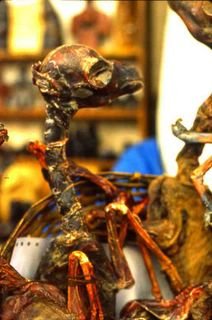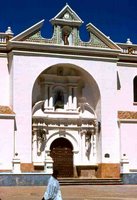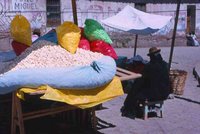
Most travelers set out for Machu Picchu from Cusco, a chocolate-brown city where Spanish colonial architecture sits atop ancient walls built by the Inca. Cusco is in the foothills of the Andes at about 11,000 feet, an altitude that creates oxygen deprivation problems for visitors who don't or can't take enough time to safely and gradually acclimate. I trust that the folks running Dana's university program will ensure that the students go slowly their first few days in Cusco and that their day trip to Machu Picchu is scheduled for the back rather than the front end of their Cusco stay.

Otherwise, somebody's bound to miss Machu Picchu. Somebody will be decked by altitude sickness, or soroche, and the excrutiatingly painful headache that is arguably its least pleasant and most frightening symptom. I've experienced brain-beating soroche in both Cusco and Lhasa, Tibet and a milder version in Quito, Ecuador. When your head feels like a crazed, invisible hand is attacking it with a hacksaw, sightseeing, even to one of the world's major wonders, is out of the question.
Mike and I went to Peru on a package tour that spent three days in Cusco. Luckily for me, the Machu Picchu excursion fell on the third day, by which time my soroche had passed. Each successive Cusco day brought a visit to increasingly spectacular Inca ruins. My Day One misery kept me in bed at the Holiday Inn while my tripmates visited Ollantaytambo, which I will always regret having missed, but by Day Two I felt human enough to join the tour of spectacular Sacsayhuaman, spread across a hillside overlooking the city. By Machu Picchu day, my head didn't hurt one bit -- although my stomach was nauseated and roiling from the juice of all the coca leaves I'd chewed to help dull my headache. Mike had bought me a giant plastic bag of coca leaves from a sidewalk vendor. Both natives and tourists chew the stuff all day.

One member of our tour group -- I think his name was Ed, so I'll call him Ed -- wasn't as lucky as me. Ed's soroche seized him on arrival in Cusco and didn't let go until the morning of our departure on Day Four. Ed missed Ollantaytambo, Sacsayhuaman, the rich sights of Cusco itself. And Ed missed Machu Picchu.
Early in the morning on Machu Picchu day, the day that was everyone's raison d'etre for traveling to Peru in the first place, we unafflicted tourists gathered in the Holiday Inn lobby bubbling with anticipation and excitement. The tour leader did a head count: one shy. Sadly, Ed was evidently still abed.
Then he appeared. Ed hobbled down the stairs, entered the lobby, sat in a straight-backed wooden chair, leaned his head against the wall, and began to cry. Some of us cried, too. Then we left without him.
Machu Picchu was spectacular beyond description. To see it, stand in it, revel in the knife-like, velvet-green peaks that surround it is a powerful, enduring experience.

But the glory of the experience was tempered by the knowledge that Ed, who, like us, had traveled a quarter of the globe expressly to stand in this remarkable place, wasn't there.
When we got back to the Holiday Inn, Ed was in the lobby, in the straight-backed chair, and his sad, expectant face knocked any residual joy out of us. An unspoken pact united everyone in the group. When Ed asked, "How was it?" we made our faces long and mumbled, "It was OK" and quickly dispersed to our respective rooms.












